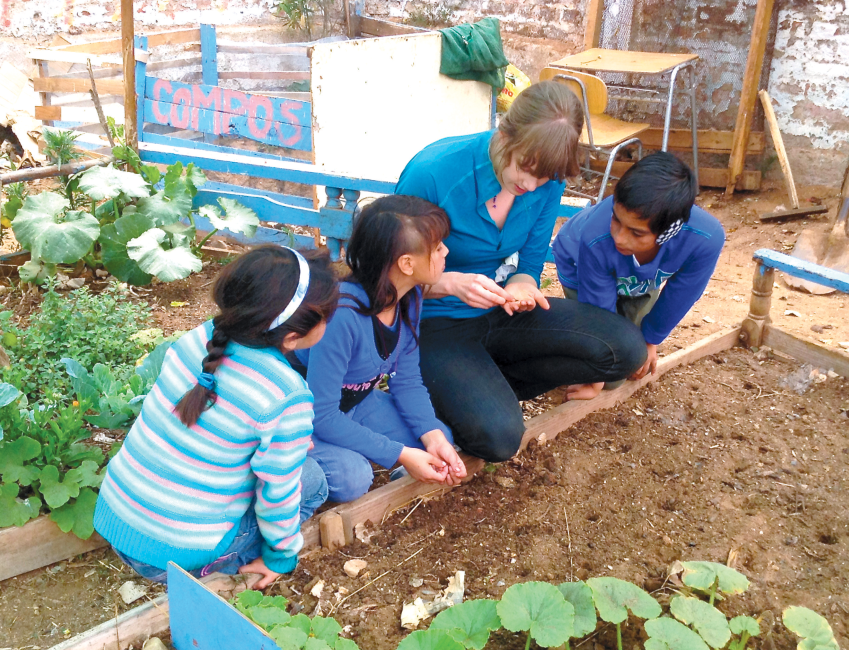Kids Table: Up North Meets Way Down South
One of the reasons I love gardening so much is that you can produce so much, with really so little. Soil, water, and a sprinkle of seeds can produce a bed full of lettuce. Kitchen scraps and dried leaves can be recycled and transformed into nutrient-rich compost to improve soil fertility. Cayenne pepper and soapy water combined creates a natural pest deterrent.
Gardening is also a wonderful example when teaching youth about being creative and using the resources around us. Reduce, reuse, recycle. Reduce our waste, reuse seemingly useless household objects, and recycle nutrients back into our soil.
Here in the US I have seen some wonderful, resourceful gardening and agricultural practices. Everything from creating container gardens out of old boots and bathtubs, to using metallic pie tins and beer cans to keep deer out of a field of Brassicas. And stay out!
Recently, I had the chance to experience a gardening program that absolutely exemplified this resourceful and enterprising attitude.
This January, I escaped the winter cold of Wisconsin and spent three weeks in Valparaiso, Chile to work with the YMCA of Valparaiso, training staff in organic gardening principles, and teaching youth about gardening and where our food comes from.
The first time I saw the garden at the YMCA’s partner community center, I knew I was in an inventive place. Every garden implement, planting container, you name it, was made out of a repurposed item. Around newly planted trees, reservoirs for holding water were constructed out of recycled bottles, fortified by stuffing them full of candy and chip wrappers. Raised beds were created out of recycled lumber, logs, and tires. As I worked with the staff and children, I was able to see this thrifty, creative spirit in action.
In preparation for a lesson on Vermiculture and worm composting, I volunteered to stop by a local store and pick up plastic containers to create worm bins, but I was told there was no need, they had something in mind. The next day, an old freezer chest appeared, the perfect vessel for starting a massive worm house—to the delight of all the youth gardeners.
The garden already had a nice compost system going. The only problem was the compost sifter was inefficient at separating finished compost due to extra-large holes in the sifting screen. After describing what would be ideal to use, someone showed up an hour later with an old, chained bed frame, with perfect-sized holes. It worked like a charm and allowed us to sift even larger amounts of compost at once, involving as many children as could fit around the bed frame.
As I could not travel with a lot of big items or seeds (though I thought about smuggling a few through customs), and the center was limited on supplies, we had to get creative with the games, activities and lessons taught in the garden each day.
Using recycled newspaper, we created paper pots to start new plants. Without watering cans, we held watering relay races that allowed everyone to participate, simply using a bucket and cups borrowed from the kitchen. Youth learned what seeds need to grow big and strong as we role-played, imagining we were little seeds growing in the garden, receiving soil, sun, water and air.
Each afternoon before starting gardening activities, I ate lunch with the kids and volunteers. Our noon meal usually consisted of different variations of stew filled with either beans, lentils, meat and veggies (corn, peas, carrots, and tomatoes), and of course fresh baked bread, as no Chilean meal is complete without it!
One of my favorite moments happened while lunching with the young gardeners one afternoon. We were going back and forth with the English and Spanish words for the veggies found in our stew. Zanahorias = Carrots, Apio = Celery, Espinacas = Spinach.
One student asked how do you say “Acelga” in English. I have no idea, I replied. I had never heard of that veggie before. The group then started to describe it for me, “it’s green, it’s a leaf!” I ran through all the vegetables I could think of in Spanish that fit that description, but still no luck.
Finally, one kid lept up and started to run towards the compost pile, shouting behind him, “we ate acelga for lunch yesterday!” A gang of children followed him towards the heap, and after a few minutes of digging, they all came back proudly waving leaves of Swiss Chard.
I will always remember the warm, vivacious and creative spirit of the Chilean people, and the hospitality they showed me during my stay!
Below are some of the gardening games and activities we enjoyed playing in Valparaiso that only require items found in nature, a few common household objects, and a touch of imagination:
Bug Races!
1. Create a large circle out of chalk, or out of sticks.
2. Chat about how there are great insects that live in the garden! Worms create tunnels, providing air and nutrients to plants roots. Ladybugs eat the bad bugs that like to munch on the leaves of our veggies.
3. Go on a hunt for critters that live in the garden. Check under logs and rocks—roly-polys and beetles work best.
4. Once everyone has found a bug, instruct all participants to place their closed fist (containing their insect) in the center of the circle.
5. On the count of three, everyone opens their fist and the race begins!
6. First bug to crawl outside the circle wins!
Garden Scavenger Hunt
Garden scavenger hunts are one of my favorite garden activities as they can be tailored to fit every age group as well as used as a nice tool for reviewing lessons and concepts.
Preschool – Have children search for different colors, texture and shapes in the garden. (Find something blue, something that smells nice, something crunchy!)
K-5 – Wrap up a lesson on composting by having students search for items that can be composted. (Find a nitrogen/green source, find a carbon/brown source, find something to be recycled.)
Make sure to set perimeter guidelines before beginning. Break older students into teams and give them a list of things to find. Compare the findings between teams as there are always multiple answers to one question.
Francie’s Spanish/English language lesson
Zanahorias = carrots
Apio = celery
Espinacas = spinach
Acelga = chard
About Valparaiso, Chile:
• Chile is in the Southern Hemisphere, so their seasons are opposite of those in the States.
• While central Chile (where Valparaiso is located) has a drier climate than Wisconsin, people there can grow many of the same crops we enjoy here, including squash, beets and spinach.
• Even in the winter, temperatures in Valparaiso rarely go below 45 degrees F, so tropical plants like mango, avocado and agave also grow in Chile.
Registration for Wellspring’s 2014 Farm Camps is Now Open!
At Wellspring Summer Farm Camps, youth learn practical gardening skills while connecting with and where our food comes from, and experiencing how plants grow! Campers will discover what life is like on an organic farm as they try new vegetables and fruits, help with chicken chores, and explore soil, flowers, insects and worms, while playing nature-based games and creating garden-inspired art.
Wellspring Farm Camp offers both one-, three- and five-day sessions to accommodate busy summer schedules. Programs are available for youth ages 6 to 16 and draw families from Milwaukee and the southeastern WI region. For more information and registration forms, please visit wellspringinc.org.
Wellspring is a nonprofit education and retreat center as well as a certified organic farm and CSA whose mission is to inspire and teach people to grow, prepare and eat healthy food.






